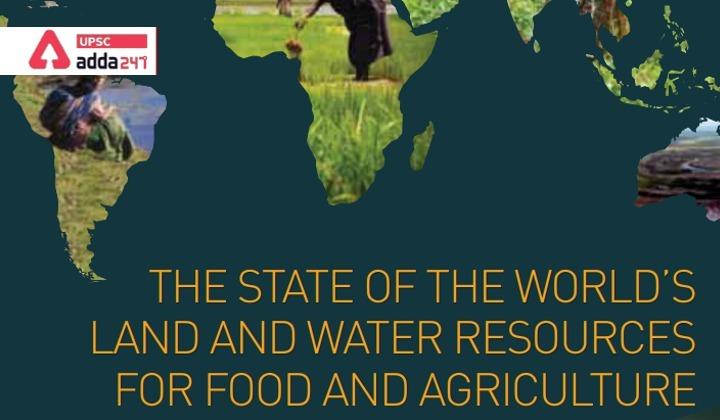Table of Contents
SOLAW Report 2021: Relevance
- GS 3: Conservation, environmental pollution and degradation, environmental impact assessment.
SOLAW Report 2021: Context
- Recently, FAO has released the State of the World’s Land and Water Resources for Food and Agriculture (SOLAW) Report 2021 to enable policymakers to assess the direction and nature of changes needed to advance sustainable management of land and water resources.
SOLAW Report 2021: Key findings
Climate change
- Climate change has increased pressure on rain-fed and irrigation production over and above the environmental consequences of decades of unsustainable use.
Human-induced land degradation
- Human pressure on land, soils and freshwater have intensified, pushing these resources to their production limits.
- Grassland and shrub-covered areas used to graze animals or as sources of fodder have declined by 191 million hectares over two decades, to 3,196 million ha in 2019, and converted to cropland.
- Population increases have meant agricultural land available per capita for crops and animal husbandry declined by 20 per cent between 2000 and 2017 to 0.19 ha /capita in 2017.
- Almost a third of rain-fed cropland and nearly a half of irrigated land are subject to human-induced land degradation.
Soil salinity
- Soil salinity is estimated to take up 5 million ha of cropland out of production each year.
Urban areas
- Urban areas occupied less than 0.5 per cent of the Earth’s land surface in 2000.
- The rapid growth of cities had a significant impact on land and water resources.
- In 2018, 55 per cent of the world’s population were urban dwellers.
Agricultural encroachment
- Most pressures on the world’s land, soil and water resources are from agriculture. There has been an increase in use of chemical (non-organic) inputs; uptake of farm mechanisation; and overall impact of higher mono-cropping and grazing intensities are concentrated on a diminishing stock of agricultural land.
Addressing hunger
- By 2050, agriculture will need to produce almost 50 per cent more food, livestock fodder and biofuel than in 2012 to satisfy global demand and keep on track to achieve “zero hunger” by 2030.
- Progress made in reducing the number of undernourished people in the early part of the 21st century has been reversed. The number has risen to 768 million in 2020 from 604 million in 2014.
SOLAW message to the countries
- The interconnected systems of land, soil and water are stretched to the limit.
- Current patterns of agricultural intensification are not proving sustainable.
- Farming systems are becoming polarized. It means Large commercial holdings now dominate agricultural land use, while fragmentation of smallholders concentrates subsistence farming on lands susceptible to degradation and water scarcity.
SOLAW suggestions
- Land and water governance has to be more inclusive and adaptive.
- Integrated solutions need to be planned at all levels if they are to be taken to scale.
- Technical and managerial innovation can be targeted to address priorities and accelerate transformation.
- Agricultural support and investment can be redirected towards social and environmental gains derived from land and water management.
Also Read:





 TSPSC Group 1 Question Paper 2024, Downl...
TSPSC Group 1 Question Paper 2024, Downl...
 TSPSC Group 1 Answer key 2024 Out, Downl...
TSPSC Group 1 Answer key 2024 Out, Downl...
 Cabinet Ministers of India 2024, New Cab...
Cabinet Ministers of India 2024, New Cab...







